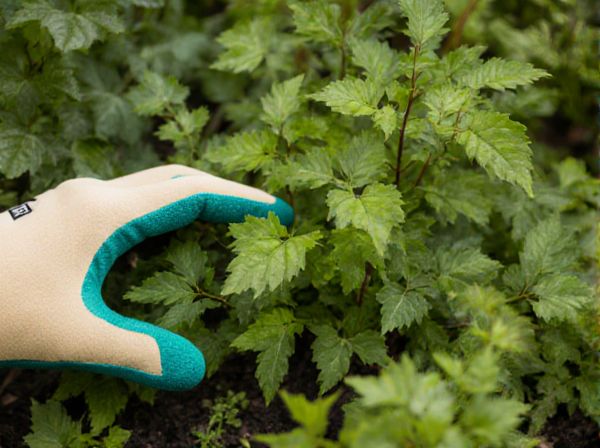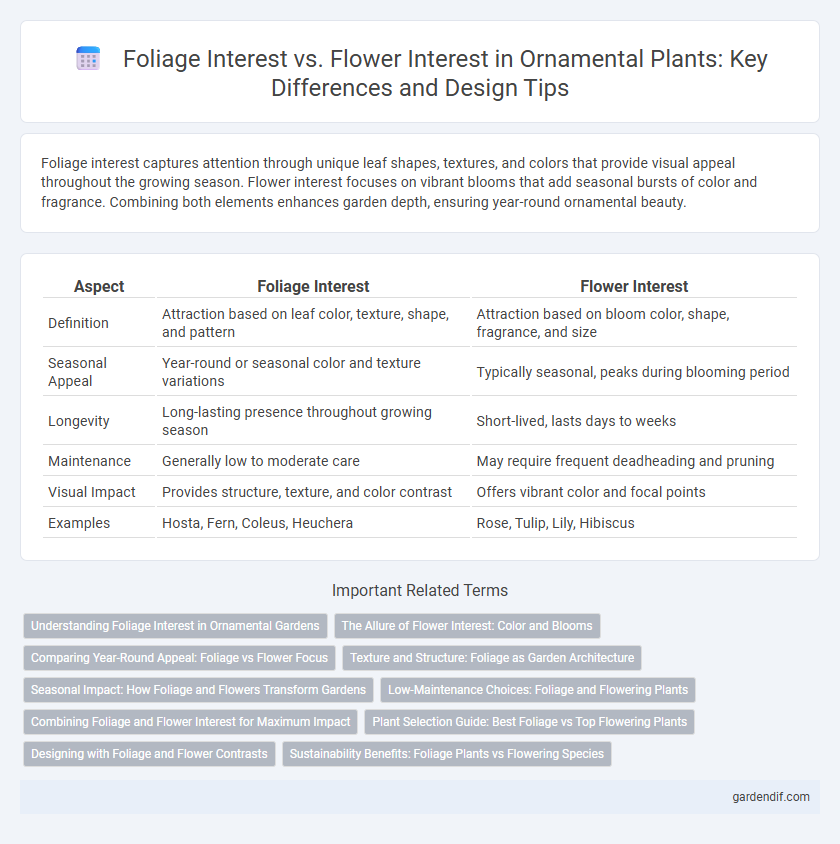
Foliage Interest vs Flower Interest Illustration
Foliage interest captures attention through unique leaf shapes, textures, and colors that provide visual appeal throughout the growing season. Flower interest focuses on vibrant blooms that add seasonal bursts of color and fragrance. Combining both elements enhances garden depth, ensuring year-round ornamental beauty.
Table of Comparison
| Aspect | Foliage Interest | Flower Interest |
|---|---|---|
| Definition | Attraction based on leaf color, texture, shape, and pattern | Attraction based on bloom color, shape, fragrance, and size |
| Seasonal Appeal | Year-round or seasonal color and texture variations | Typically seasonal, peaks during blooming period |
| Longevity | Long-lasting presence throughout growing season | Short-lived, lasts days to weeks |
| Maintenance | Generally low to moderate care | May require frequent deadheading and pruning |
| Visual Impact | Provides structure, texture, and color contrast | Offers vibrant color and focal points |
| Examples | Hosta, Fern, Coleus, Heuchera | Rose, Tulip, Lily, Hibiscus |
Understanding Foliage Interest in Ornamental Gardens
Foliage interest in ornamental gardens emphasizes the texture, color, and shape of leaves to create visual appeal throughout the growing season. Variegated, textured, and uniquely shaped leaves provide continuous interest even when flowers are not in bloom, enhancing garden structure and depth. Selecting plants with diverse foliage ensures year-round beauty and dynamic contrast, complementing seasonal flowering displays.
The Allure of Flower Interest: Color and Blooms
Flower interest captivates gardens with vibrant colors and dynamic blooms that change throughout seasons, offering visual variety and appeal. Unlike foliage, flowers contribute to pollinator attraction, enhancing biodiversity and ecological balance. Their diverse shapes and hues create focal points, elevating ornamental design beyond static greenery.
Comparing Year-Round Appeal: Foliage vs Flower Focus
Foliage interest offers consistent year-round appeal through vibrant colors, textures, and shapes that change with the seasons, providing garden structure even in dormant months. Flowers deliver intense but often brief bursts of color, primarily in spring and summer, making them ideal for seasonal focal points. Prioritizing foliage ensures continuous garden interest and low maintenance, while flower-focused designs maximize visual impact during peak bloom periods.
Texture and Structure: Foliage as Garden Architecture
Foliage provides essential texture and structure that define garden architecture, offering year-round visual interest beyond seasonal blooms. The layered patterns of leaves create dynamic contrasts and depth, often shaping the overall composition more effectively than flowers. Gardens designed with a focus on foliage emphasize form, color variation, and tactile qualities that enhance spatial rhythm and continuity.
Seasonal Impact: How Foliage and Flowers Transform Gardens
Foliage interest offers year-round texture, color, and structure, creating a dynamic backdrop that evolves with the seasons. Flower interest peaks during specific blooming periods, providing bursts of vibrant color and fragrance that highlight seasonal transitions. Together, foliage and flowers transform gardens by balancing continuous greenery with striking floral displays, enhancing visual appeal throughout the year.
Low-Maintenance Choices: Foliage and Flowering Plants
Foliage interest in ornamental gardening offers low-maintenance options with plants like hostas and ferns that provide texture and color year-round, reducing the need for frequent care. Flowering plants such as coneflowers and daylilies also deliver seasonal blooms while requiring minimal watering and pruning, making them practical for sustainable gardens. Combining both foliage and flowering plants maximizes garden appeal and resilience with efficient resource use.
Combining Foliage and Flower Interest for Maximum Impact
Combining foliage interest with flower interest creates a dynamic and visually captivating garden that maintains appeal throughout the seasons. Varied leaf textures, colors, and shapes provide a complementary backdrop that enhances vibrant blooms and extends aesthetic value beyond flowering periods. Strategic layering of evergreen foliage with seasonal flowers maximizes garden depth and ensures continuous visual stimulation.
Plant Selection Guide: Best Foliage vs Top Flowering Plants
Selecting plants with strong foliage interest enhances garden texture and year-round appeal, with options like hostas, ferns, and caladiums providing vibrant leaves that change color and form through seasons. Top flowering plants such as roses, hydrangeas, and azaleas offer dynamic bursts of color, attracting pollinators and creating focal points in ornamental landscapes. Balancing foliage and flowering selections ensures a visually captivating garden, combining structural greenery with seasonal floral displays for optimal aesthetic impact.
Designing with Foliage and Flower Contrasts
Designing with foliage and flower contrasts enhances garden depth by balancing texture, color, and form, creating dynamic visual appeal throughout seasons. Foliage interest offers sustained structure with diverse leaf shapes, tones, and patterns, while flower interest provides vibrant bursts of color and seasonal variation. Combining both elements maximizes year-round ornamental value, supporting harmonious yet striking landscape compositions.
Sustainability Benefits: Foliage Plants vs Flowering Species
Foliage plants offer significant sustainability benefits compared to flowering species, requiring less water and fewer fertilizers due to their hardy, drought-tolerant characteristics. Their long-lasting leaves provide year-round aesthetic appeal, reducing the need for seasonal replanting and minimizing landscape waste. This makes foliage plants an eco-friendly choice for sustainable gardening by enhancing carbon sequestration and promoting biodiversity.
Foliage Interest vs Flower Interest Infographic

 gardendif.com
gardendif.com